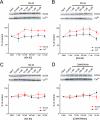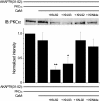Ca2+/calmodulin-dependent protein kinase II inhibitors disrupt AKAP79-dependent PKC signaling to GluA1 AMPA receptors
- PMID: 21156788
- PMCID: PMC3057809
- DOI: 10.1074/jbc.M110.183558
Ca2+/calmodulin-dependent protein kinase II inhibitors disrupt AKAP79-dependent PKC signaling to GluA1 AMPA receptors
Abstract
GluA1 (formerly GluR1) AMPA receptor subunit phosphorylation at Ser-831 is an early biochemical marker for long-term potentiation and learning. This site is a substrate for Ca(2+)/calmodulin (CaM)-dependent protein kinase II (CaMKII) and protein kinase C (PKC). By directing PKC to GluA1, A-kinase anchoring protein 79 (AKAP79) facilitates Ser-831 phosphorylation and makes PKC a more potent regulator of GluA1 than CaMKII. PKC and CaM bind to residues 31-52 of AKAP79 in a competitive manner. Here, we demonstrate that common CaMKII inhibitors alter PKC and CaM interactions with AKAP79(31-52). Most notably, the classical CaMKII inhibitors KN-93 and KN-62 potently enhanced the association of CaM to AKAP79(31-52) in the absence (apoCaM) but not the presence of Ca(2+). In contrast, apoCaM association to AKAP79(31-52) was unaffected by the control compound KN-92 or a mechanistically distinct CaMKII inhibitor (CaMKIINtide). In vitro studies demonstrated that KN-62 and KN-93, but not the other compounds, led to apoCaM-dependent displacement of PKC from AKAP79(31-52). In the absence of CaMKII activation, complementary cellular studies revealed that KN-62 and KN-93, but not KN-92 or CaMKIINtide, inhibited PKC-mediated phosphorylation of GluA1 in hippocampal neurons as well as AKAP79-dependent PKC-mediated augmentation of recombinant GluA1 currents. Buffering cellular CaM attenuated the ability of KN-62 and KN-93 to inhibit AKAP79-anchored PKC regulation of GluA1. Therefore, by favoring apoCaM binding to AKAP79, KN-62 and KN-93 derail the ability of AKAP79 to efficiently recruit PKC for regulation of GluA1. Thus, AKAP79 endows PKC with a pharmacological profile that overlaps with CaMKII.
Figures






Similar articles
-
CaMKII regulates the depalmitoylation and synaptic removal of the scaffold protein AKAP79/150 to mediate structural long-term depression.J Biol Chem. 2018 Feb 2;293(5):1551-1567. doi: 10.1074/jbc.M117.813808. Epub 2017 Dec 1. J Biol Chem. 2018. PMID: 29196604 Free PMC article. Review.
-
AKAP79 selectively enhances protein kinase C regulation of GluR1 at a Ca2+-calmodulin-dependent protein kinase II/protein kinase C site.J Biol Chem. 2008 Apr 25;283(17):11445-52. doi: 10.1074/jbc.M709253200. Epub 2008 Feb 27. J Biol Chem. 2008. PMID: 18305116 Free PMC article.
-
Preferential generation of Ca2+-permeable AMPA receptors by AKAP79-anchored protein kinase C proceeds via GluA1 subunit phosphorylation at Ser-831.J Biol Chem. 2019 Apr 5;294(14):5521-5535. doi: 10.1074/jbc.RA118.004340. Epub 2019 Feb 8. J Biol Chem. 2019. PMID: 30737285 Free PMC article.
-
Ca2+/calmodulin-dependent protein kinase II binds to and phosphorylates a specific SAP97 splice variant to disrupt association with AKAP79/150 and modulate alpha-amino-3-hydroxy-5-methyl-4-isoxazolepropionic acid-type glutamate receptor (AMPAR) activity.J Biol Chem. 2010 Jan 8;285(2):923-34. doi: 10.1074/jbc.M109.033985. Epub 2009 Oct 26. J Biol Chem. 2010. PMID: 19858198 Free PMC article.
-
Regulation of neuronal PKA signaling through AKAP targeting dynamics.Eur J Cell Biol. 2006 Jul;85(7):627-33. doi: 10.1016/j.ejcb.2006.01.010. Epub 2006 Feb 28. Eur J Cell Biol. 2006. PMID: 16504338 Review.
Cited by
-
Signaling pathways involved in striatal synaptic plasticity are sensitive to temporal pattern and exhibit spatial specificity.PLoS Comput Biol. 2013;9(3):e1002953. doi: 10.1371/journal.pcbi.1002953. Epub 2013 Mar 14. PLoS Comput Biol. 2013. PMID: 23516346 Free PMC article.
-
CaMKII regulates the depalmitoylation and synaptic removal of the scaffold protein AKAP79/150 to mediate structural long-term depression.J Biol Chem. 2018 Feb 2;293(5):1551-1567. doi: 10.1074/jbc.M117.813808. Epub 2017 Dec 1. J Biol Chem. 2018. PMID: 29196604 Free PMC article. Review.
-
Studying CaMKII: Tools and standards.Cell Rep. 2024 Apr 23;43(4):113982. doi: 10.1016/j.celrep.2024.113982. Epub 2024 Mar 21. Cell Rep. 2024. PMID: 38517893 Free PMC article. Review.
-
LTP expression mediated by autonomous activity of GluN2B-bound CaMKII.Cell Rep. 2024 Oct 22;43(10):114866. doi: 10.1016/j.celrep.2024.114866. Epub 2024 Oct 11. Cell Rep. 2024. PMID: 39395168 Free PMC article.
-
FRET-based sensor for CaMKII activity (FRESCA): A useful tool for assessing CaMKII activity in response to Ca2+ oscillations in live cells.J Biol Chem. 2019 Aug 2;294(31):11876-11891. doi: 10.1074/jbc.RA119.009235. Epub 2019 Jun 14. J Biol Chem. 2019. PMID: 31201271 Free PMC article.
References
-
- Tokumitsu H., Chijiwa T., Hagiwara M., Mizutani A., Terasawa M., Hidaka H. (1990) J. Biol. Chem. 265, 4315–4320 - PubMed
-
- Sumi M., Kiuchi K., Ishikawa T., Ishii A., Hagiwara M., Nagatsu T., Hidaka H. (1991) Biochem. Biophys. Res. Commun. 181, 968–975 - PubMed
-
- Humphreys B. D., Virginio C., Surprenant A., Rice J., Dubyak G. R. (1998) Mol. Pharmacol. 54, 22–32 - PubMed
Publication types
MeSH terms
Substances
Grants and funding
LinkOut - more resources
Full Text Sources
Molecular Biology Databases
Miscellaneous

